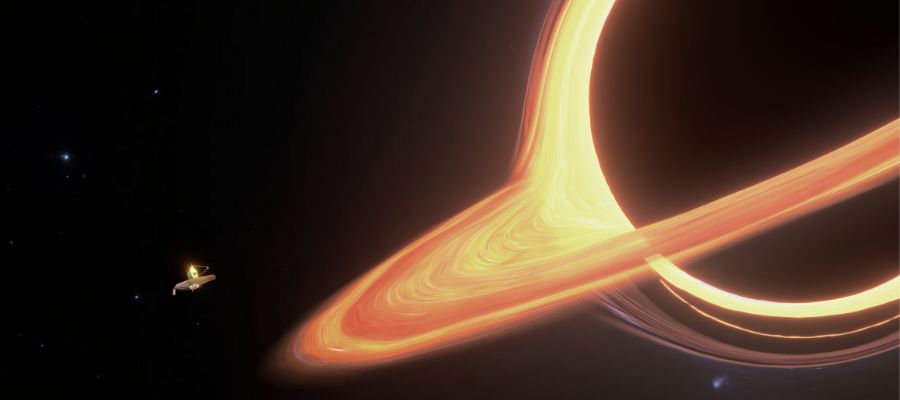
Jeff Tallon is a Professor of Physics at Victoria University of Wellington, and concurrently an Emeritus Investigator at the MacDiarmid Institute for Advanced Materials and Nanotechnology. Jeff is also a New Zealand Christians in Science Advisor.
1.5 million kilometres from planet earth, in the cold silence of space, the James Webb Space Telescope (JWST) has been focussing its 18 mirrors on the far reaches of outer space and returning utterly spectacular images of stars, galaxies and the neighbourhoods of black holes. Planned for some 25 years and launched on Christmas Day 2021, JWST was placed in a highly stable orbit – the so-called Lagrange point (note below) – at a total cost of $16 billion. Despite the huge cost the American public, having seen the images, seems to be right behind the project.
It’s not surprising. The image below from JWST is of the most distant galaxy ever observed. It is some 13.5 billion light years away. The light arriving at the telescope left this galaxy just 320 million years after the Big Bang – long, long before our sun was formed, and perhaps just 100 million years after the very first stars and galaxies appeared. If JWST could look back further there would be no galaxies to observe. This particular youngster comprises about 1 billion stars and is some 4,000 light years in diameter. To put that in perspective, our own Milky Way galaxy has about 200 billion stars and is 100,000 light-years across. So this galaxy may be smaller but it is about 10 times more dense.
This image is a tiny part of a much grander deep-field image shown below that reveals a dense array of ancient galaxies (the fuzzy objects) together with a dozen or so nearer stars in the foreground (with hexagonal rays). Also of note are the elongated curved images having a ringed appearance which arise from ‘gravitational lensing’. Some massive but invisible object, possibly a black hole, lies more to the foreground and, due to the bending of light by gravity, acts like a lens distorting and focussing the light from the more distant objects. These objects sit at the very edge of time, some half a billion years younger than Hubble could see in its Ultra Deep Field images. They are young galaxies that have not seen the long evolution of our own galaxy and solar system and therefore comprise mainly the primordial hydrogen and helium created in the Big Bang. The heavier elements of our own solar system were formed over long periods of time from supernova explosions and the collisions of black holes and neutron stars. How do we know these youthful galaxies are from the distant past? The optical spectra from their constituent atoms are shifted in frequency in proportion to the velocity at which they recede from us. The most distant galaxies are receding faster. This is the so-called ‘red-shift’ and can be used routinely to characterise their recession speed and distance.
Another superb image from JWST is that of Stephan’s Quintette – a cluster of five galaxies visible just under the lower foot of the constellation Pegasus. It was discovered by Édouard Stephan in 1877 in Marseille, France. The image shows a vast number of galaxies in the background and a few nearby stars in the foreground. But the major images are those of the five diffuse galaxies dominating the cluster. The four to the right all lie about 290 million light years away and are interacting violently with each other, each attempting to gobble up matter from the others. The galaxy to the left is much closer at about 40 million light years and therefore isolated from this voracious tussle. The topmost galaxy NGC7319 is a barrel spiral galaxy with a supermassive black hole at its centre having a mass 24 million times that of our sun. It is sucking in and devouring vast quantities of matter and duly emitting light energy equivalent to some 40 billion suns!
These beautiful images are made possible due to the ultra-high resolution of JWST. To illustrate just how good its resolution is compared with other space telescopes the figure below shows a comparison first with an image from the Wide-field Infrared Survey Explorer (WISE) launched in 2009. The second image is from the Spitzer Space Telescope InfraRed Array Camera (IRAC) launched in 2003 and now retired. The third illustrates the comparative pinpoint resolution of JWST. JWST not only has high resolution it is designed to detect objects 100 times fainter than Hubble can discern.
But the distinctive thing about all these images is that they are invisible to the eye – not just because they are impossibly faint, not just because they are the merest of points, much finer than the resolution of the human eye, but because they are taken from outside the visible spectrum. JWST images are in the infrared. Indeed, much of modern astronomy and cosmology is concerned with making the invisible visible.
We have just recently celebrated Matariki. Much of Matariki is invisible to the naked eye – we can see just 7 to 9 of the stars in the cluster. When Galileo first trained his telescope on Pleiades he identified 36. Now we know there are thousands and their collective motions against the starry background have been modelled and mapped over 400,000 years, going back and forward in time. Coincidentally, the most popular picture on Wikipedia was voted to be one of Pleaides but it is a false-colour composite built from the invisible parts of the spectrum. Nowadays we can see the invisible, can’t we? There is much more to the world than meets the eye.
At heart “seeing the unseen” defines our humanity. Certainly, it drives the entire scientific enterprise. We make tools to render the invisible, visible. We develop mathematics to make the unfathomable, fathomable. But as humans, we do not merely respond to our immediate circumstances, reactively, in knee-jerk fashion. But we transport ourselves out of those circumstances to consider a wider perspective – be that with an eye to the imagined future, or to consequences, or to insights, or to the other person’s perspective.
We see the unseen in every situation we find ourselves and we govern our actions accordingly. Much of what we do is with an eye to the future, or we dig deeper to try to understand what we do not yet understand, or we interpret what is in front of our eyes to create deeper meaning. Think about it:
- Seeing the unseen drives our response to the law – we are conscious of consequences!
- Seeing the unseen drives our unstoppable urge for art and creative expression;
- It drives our attitudes to training for education and sport because we envisage success at some point in the future;
- And it drives the human urge for religion – to attempt to understand our place in the cosmos and respond accordingly.
Of course, we begin our lives living purely reactively – I’m hungry, I’m hurting, I’m tired, I’m thirsty. And we demand accordingly. But quite rapidly we grow up, transporting ourselves into a conceptual and abstract world that takes us beyond the immediate and begins to dictate a less reactive, more measured behaviour. Some grow up faster than others!
I love to think of those Babylonian astronomers more than 2500 years ago who calculated mathematically that an eclipse had occurred below the horizon. They record precisely where it occurred in the sky, and when, and for how long, and then added in their log books “I did not see it – it was below the horizon”.
That’s a huge leap for humanity to realize that an abstract mathematical calculation on paper (or clay?) corresponds to physical reality even if not actually seen! Seeing the unseen!Or consider Eratosthenes about 200 BC, who, by measuring the angle of the sun’s shadow on mid-summer’s day at Alexandria and at Aswan, accurately deduced that planet Earth was a sphere with a circumference of 40,000 km – as we know it to be today. Seeing the unseen!
As a Christian I hold to the view that there is more to life than what we see in the physical realm. Truth is not confined to physical reality but reaches deep into the unseen from which we derive moral sensibility, and a profound sense of place and meaning. And if indeed the physical universe is Created then ultimate truth surely is to be found in the search for our Creator. We as humans build our lives around the as-yet unseen and it is only natural that we should reach out to the ultimate Unseen. But just as there are disciplines to establishing truth in the physical scientific realm there must be disciplines in the search for truth in the spiritual realm. It cannot be open slather otherwise silliness often prevails. Data, evidence, peer-review and commitment are all required. As Jeremiah stated 2500 years ago “You will surely find Me when you seek for Me with all your heart”.
Note: The Lagrange point lies in a straight line from Sun to Earth and 1.5 Mkm beyond. At this location the pull of gravity from both Sun and Earth are acting in concert and are perfectly balanced by the centrifugal force due to JWST’s orbit around Earth.



